Every year, about 4,400 babies are born in the US with a cleft palate or cleft lip. Clefts are among the most common birth defects in the nation. Parents will have received a cleft lip ultrasound diagnosis during check-ups, but a cleft palate ultrasound doesn’t result in as easy a diagnosis. Although this can be worrying and distressing news for parents, it’s reassuring to know that cleft palate treatment is widely practiced and very successful.
Here, we’ll walk you through some of the common questions people have about these conditions. We’ll explain the difference between a cleft palate and lip, cleft palate and cleft lip causes, and what cleft lip and cleft palate surgery involves. You can also read about the implications for your child’s teeth, and how to address possible complications that may occur after surgery to repair an oral cleft.
What is a cleft palate?
We can define the upper ‘palate’ as the roof or top of your mouth. The definition of a ‘cleft’ is a divide or split in something. So, the cleft palate definition is a hole or gap in the roof of the mouth. If there is a gap on both sides of the mouth, this is known as a bilateral cleft palate.
A soft cleft palate is when the gap occurs to the back of the mouth, towards the throat, and a hard cleft palate is when the cleft is towards the teeth. Some people develop only a soft cleft palate, while for others both the soft and hard parts of the roof of the mouth are affected.
What is a cleft lip?
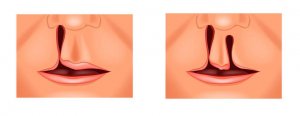

Cleft lip used to be called harelip (sometimes understandably misspelled as hairlip). The definition of a cleft lip is when there is a gap, or notch, on one or both sides of the lip, sometimes reaching as far up as the nostrils.
A bilateral cleft lip is when there are two notches, whereas a unilateral cleft lip is when there is only one notch or gap. Cleft lip repair and surgery will be the same whether your baby has a bilateral or unilateral cleft lip.
Most children with a cleft lip or cleft palate undergo a corrective procedure within their first 18 months of life. The number of surgical procedures necessary to repair the cleft will depend on the extent of the child’s condition.
A team of specialists is usually involved in a cleft lip or palate repair, including an oral surgeon, dentist and a pediatrician. Depending on the child’s age, a speech pathologist may also be involved to help them establish proper articulation.
Dr. Rick Kapitan DDS
What causes cleft lip and cleft palate?
The answer to what causes cleft palate and what causes cleft lip is generally the same, although a cleft palate on its own is more common, accounting for about 45% of cases. Doctors are unsure about exact cleft lip and cleft palate causes, but there are some ideas, including:
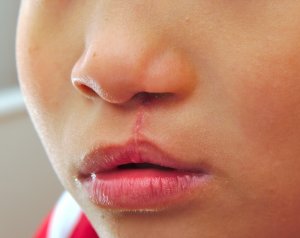

- Genetics: Genes inherited from one or two parents can stop the lip and mouth from joining while in the womb. There are hundreds of genetic syndromes that include cleft palate as a symptom. In fact, 30% of all clefts are related to a genetic syndrome.
- Smoking and drinking alcohol during pregnancy: Certain studies suggest a small but significant increase in the chances of cleft palates and lips when tobacco and alcohol are used during pregnancy.
- Obesity during pregnancy: This point is a bit controversial, but scientific studies have found links between a mother’s weight whilst carrying her baby and a baby with a cleft palate and/or lip.
- Lack of folic acid during pregnancy: Folic acid is already known to be important for women when pregnant, and there are studies that say the risks of cleft lip and cleft palate in babies are reduced with taking folic acid.
- Certain medications taken while pregnant: Medication that can prevent seizures, and some steroids, have been linked to cleft lip in babies as well as cleft palates.
How do oral clefts form?
When a fetus has been developing for about 4-7 weeks, the skull and face begin to grow. An oral cleft occurs when the front part of the face doesn’t join up fully, causing an opening in the lips.
Your cupid’s bow, or the little indent between your septum and top lip is where the face normally finishes joining together and there will normally be a very small indent, or cleft, here. This cleft under the nose is known as your philtrum.
Cleft palate and cleft lip symptoms
Cleft palate babies have slightly different problems than cleft lip babies. You might find a cleft lip or palate causes some or all of these issues:
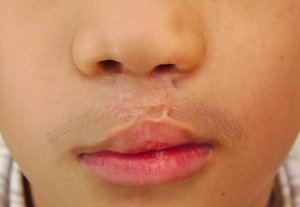

- Cleft lip babies may have some problems breast or bottle feeding because they can’t form a seal. There are special teats for bottles that will help a baby to feed.
- Cleft palate babies can be more likely to have some hearing problems and get more ear infections because they have problems draining fluid from around the ear.
- Even after surgery, sometimes a cleft palate affects adults in the form of a speech problem. This can be treated with a speech therapist.
- Dental problems are common for children and adults who were born with a cleft palate; teeth can be missing or twisted. Dentists can normally fix this with braces and sometimes surgery.
Cleft lip and cleft palate treatment
When a baby is diagnosed with a cleft palate and/or lip, the American Cleft Palate – Craniofacial Association (ACPA) recommends treatment with a cleft and craniofacial team. These teams work with your child to provide a coordinated approach to treatment of your child’s cleft palate or lip. Your insurance – whether private, through the ADA or through state dental Medicaid coverage – will help cover the costs of this treatment. In addition to surgery, treatment also includes/addresses:
- Feeding difficulties
- Regular hearing checks
- Help before and after cleft surgery
- Speech therapy
- Correct dental care
Cleft lip repair
When a cleft lip baby is around 3-6 months old they will be able to have cleft lip surgery. It is normally pretty simple, done in about 2 hours while the baby is under general anesthetic. The two parts of the lip will usually be stitched together and secured with dissolvable stitches.
Many people often think of birth defects like cleft lip and palate as unfortunate cosmetic issues but children with the condition also experience other health-related side effects. Patients often have problems with eating and speaking clearly. They also might have hearing problems and issues with their teeth.
If the cleft extends through the upper gum, tooth development may be affected; children with clefts often have missing, extra, malformed or displaced teeth and are more prone to cavities. Patients can also have a defect in the gums or alveolar ridge – the bone that supports the teeth – and that can prevent permanent teeth from coming in properly.
Dr. Rick Kapitan DDS
If your baby has a double, or bilateral cleft lip, both gaps should be able to be treated in the same surgery. There may be more cleft lip surgery needed when they are older, depending on how well the first treatment heals.
Cleft palate repair
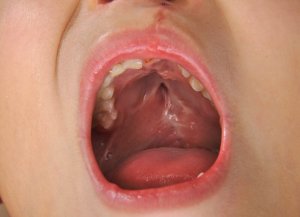

A baby with a cleft palate can receive surgery at around 6-12 months old. Cleft palate repair involves the surgeon bringing together muscle and soft tissue to close any gaps. Like with a cleft lip, if there is a bilateral, or double cleft palate they can be treated at the same time.
Bilateral cleft lip and palate surgery
Your cleft team will talk about your options if your baby has a bilateral cleft lip and/or a bilateral cleft palate. Depending on your child’s needs, cleft palate surgeries may be split up or done at different ages. Your doctor will explain the options to you, and you can ask for a second opinion if you have any concerns.
Differences between cleft lips and cleft palates
The table below shows the main differences we have discussed between these different types of oral cleft:
Cleft lip | Cleft palate | Both | |
Genetic | Not common | Not common | Not common |
Ultrasound diagnosis | Likely | Unlikely | Likely |
Increased risk of ear infections | No | Yes | Yes |
Feeding difficulties | Yes | Yes | Yes |
Age or surgery | 3-5 months | 6-12 months | Lip surgery 3-6 months; palate surgery 6-12 months |
Dental issues | Unlikely | Likely | Likely |
Speech issues | Unlikely | Likely | Likely |
Growing up after cleft lip or cleft palate surgery


A cleft lip before and after surgery will look very different. Some parents say they find it a bit hard to adjust to their child’s new smile. If you feel worried you can speak to your cleft team or seek support from the ACPA community. There’s not such a noticeable difference with a cleft palate before and after surgery, but of course, the hole or gap will be gone when your child opens their mouth.
Ear infections may still affect your child more frequently, and they might need some help from a speech therapist. There is a chance more cleft surgery will be needed to maintain the function of the mouth, nose, and lips and to improve facial esthetics. You’ll need to follow the advice of your dentist to keep your child’s teeth clean, particularly if they are misaligned.
After receiving surgery as a child for cleft palate, adults and teenagers may still need extra medical care. Sometimes teeth don’t form where the clefts were and implants or veneers may be necessary. Adult teeth can come through twisted and this could call for braces for kids as they grow up too.
Conclusion
It can be worrying for a parent to be told their baby has a cleft lip or palate: we all want our babies to be perfect. Even though your baby has a cleft, which will mean surgeries, treatment, and possibly braces and dental implants in the years ahead, they should be able to live a pretty normal life.
If you look at pictures of a cleft palate or cleft lip after surgery, such as those provided by the members of the American Cleft Palate Association here, you can see that it is not likely to have a long-term negative impact on your baby, you, or your family.
FAQs
What are the most common cleft lip and palate causes?
Doctors think that cleft palates and cleft lips are rarely genetic; probably only in about 2-8% of cases. However, they are the most common congenital birth defects. Sometimes cleft palate and cleft lip causes are actually genetic conditions that result in a cleft as a symptom.
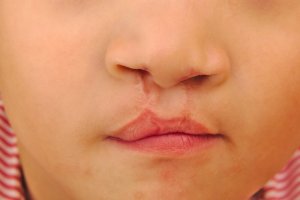

What differences are there in a person born with cleft lip before and after surgery?
After your child’s cleft lip surgery, it is common for a small scar to be visible. Your baby’s scar will fade over the years, although 97% believe there is still a physical difference later. If you look at pictures of mouths with cleft lips before and after surgery you will see that scarring is usually minimal.
What are cleft palate symptoms?
Symptoms are mainly the gaps that are visible in the palate when a baby is born. A cleft lip ultrasound can identify cleft lips before birth, whereas cleft palates are harder to diagnose. As we’ve outlined above, there are problems that arise from this but they are very treatable.
What happens if an oral cleft goes untreated?
In developing countries, some parents can’t afford to treat oral clefts in their children. Cleft lip adults have problems breathing, eating, hearing, and speaking. There are charities that fund surgery in underdeveloped countries to treat this easily fixable condition. In the following video you can see one young Mexican boy with a cleft lip before and after surgery, which was funded by the charity Smile Train:
NCBI: Maternal obesity is a risk factor for orofacial clefts: a meta-analysis. Consulted 8th April 2019.
NIH: Folic Acid May Prevent Cleft Lip and Palate Consulted 8th April 2019.
The American Journal of Public Health: Tobacco and alcohol use during pregnancy and risk of oral clefts Consulted 8th April 2019.
NIH: Cleft Lip and Palate Consulted 5 June 2019.




